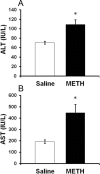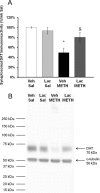Peripheral ammonia as a mediator of methamphetamine neurotoxicity
- PMID: 22993432
- PMCID: PMC3464918
- DOI: 10.1523/JNEUROSCI.2530-12.2012
Peripheral ammonia as a mediator of methamphetamine neurotoxicity
Abstract
Ammonia is metabolized by the liver and has established neurological effects. The current study examined the possibility that ammonia contributes to the neurotoxic effects of methamphetamine (METH). The results show that a binge dosing regimen of METH to the rat increased plasma and brain ammonia concentrations that were paralleled by evidence of hepatotoxicity. The role of peripheral ammonia in the neurotoxic effects of METH was further substantiated by the demonstration that the enhancement of peripheral ammonia excretion blocked the increases in brain and plasma ammonia and attenuated the long-term depletions of dopamine and serotonin typically produced by METH. Conversely, the localized perfusion of ammonia in combination with METH, but not METH alone or ammonia alone, into the striatum recapitulated the neuronal damage produced by the systemic administration of METH. Furthermore, this damage produced by the local administration of ammonia and METH was blocked by the GYKI 52466 [4-(8-methyl-9H-1,3-dioxolo[4,5-h][2,3]benzodiazepin-5-yl)-benzamine hydrochloride], an AMPA receptor antagonist. These findings highlight the importance of ammonia derived from the periphery as a small-molecule mediator of METH neurotoxicity and more broadly emphasize the importance of peripheral organ damage as a possible mechanism that mediates the neuropathology produced by drugs of abuse and other neuroactive molecules.
Figures








Similar articles
-
Peripheral ammonia and blood brain barrier structure and function after methamphetamine.Neuropharmacology. 2016 Aug;107:18-26. doi: 10.1016/j.neuropharm.2016.03.018. Epub 2016 Mar 10. Neuropharmacology. 2016. PMID: 26972828 Free PMC article.
-
Cyclooxygenase activity contributes to the monoaminergic damage caused by serial exposure to stress and methamphetamine.Neuropharmacology. 2013 Sep;72:96-105. doi: 10.1016/j.neuropharm.2013.04.040. Epub 2013 May 2. Neuropharmacology. 2013. PMID: 23643743 Free PMC article.
-
Ammonia mediates methamphetamine-induced increases in glutamate and excitotoxicity.Neuropsychopharmacology. 2014 Mar;39(4):1031-8. doi: 10.1038/npp.2013.306. Epub 2013 Oct 29. Neuropsychopharmacology. 2014. PMID: 24165886 Free PMC article.
-
Methamphetamine neurotoxicity, microglia, and neuroinflammation.J Neuroinflammation. 2018 Dec 12;15(1):341. doi: 10.1186/s12974-018-1385-0. J Neuroinflammation. 2018. PMID: 30541633 Free PMC article. Review.
-
Current research on methamphetamine-induced neurotoxicity: animal models of monoamine disruption.J Pharmacol Sci. 2003 Jul;92(3):178-95. doi: 10.1254/jphs.92.178. J Pharmacol Sci. 2003. PMID: 12890883 Review.
Cited by
-
Combined and sequential effects of alcohol and methamphetamine in animal models.Neurosci Biobehav Rev. 2021 Dec;131:248-269. doi: 10.1016/j.neubiorev.2021.09.019. Epub 2021 Sep 17. Neurosci Biobehav Rev. 2021. PMID: 34543650 Free PMC article. Review.
-
Differential effects of synthetic psychoactive cathinones and amphetamine stimulants on the gut microbiome in mice.PLoS One. 2020 Jan 24;15(1):e0227774. doi: 10.1371/journal.pone.0227774. eCollection 2020. PLoS One. 2020. PMID: 31978078 Free PMC article.
-
Peripheral ammonia and blood brain barrier structure and function after methamphetamine.Neuropharmacology. 2016 Aug;107:18-26. doi: 10.1016/j.neuropharm.2016.03.018. Epub 2016 Mar 10. Neuropharmacology. 2016. PMID: 26972828 Free PMC article.
-
Methamphetamine-Induced Brain Injury and Alcohol Drinking.J Neuroimmune Pharmacol. 2018 Mar;13(1):53-63. doi: 10.1007/s11481-017-9764-3. Epub 2017 Aug 30. J Neuroimmune Pharmacol. 2018. PMID: 28856500 Free PMC article.
-
A Mechanistic Review on Toxicity Effects of Methamphetamine.Int J Med Sci. 2025 Jan 1;22(3):482-507. doi: 10.7150/ijms.99159. eCollection 2025. Int J Med Sci. 2025. PMID: 39898237 Free PMC article. Review.
References
-
- Ago M, Ago K, Hara K, Kashimura S, Ogata M. Toxicological and histopathological analysis of a patient who died nine days after a single intravenous dose of methamphetamine: a case report. Leg Med (Tokyo) 2006;8:235–239. - PubMed
-
- Batshaw ML, Hyman SL, Mellits ED, Thomas GH, DeMuro R, Coyle JT. Behavioral and neurotransmitter changes in the urease-infused rat: a model of congenital hyperammonemia. Pediatr Res. 1986;20:1310–1315. - PubMed
-
- Brown JM, Riddle EL, Sandoval V, Weston RK, Hanson JE, Crosby MJ, Ugarte YV, Gibb JW, Hanson GR, Fleckenstein AE. A single methamphetamine administration rapidly decreases vesicular dopamine uptake. J Pharmacol Exp Ther. 2002;302:497–501. - PubMed
Publication types
MeSH terms
Substances
Grants and funding
LinkOut - more resources
Full Text Sources
Medical
